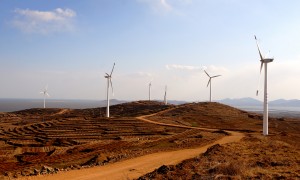 It is meant to be a visit to talk about China’s commitment to tackling climate change, but on the sidelines is the thorny issue of China’s protectionist tactics to become the world leader in renewable energy.
It is meant to be a visit to talk about China’s commitment to tackling climate change, but on the sidelines is the thorny issue of China’s protectionist tactics to become the world leader in renewable energy.
In many ways China has stolen a march on its rivals: The US and EU had the technology to become the world leaders in clean energy, but China is looking like it will come from behind to win the race. China has now passed the US as the world’s largest market for wind energy. But it’s the way in which it is doing it that is causing consternation with American and European officials.
Steven Chu, the American energy secretary, and Gary Locke, the commerce secretary visit China today to officially talk about getting China to agree to specific targets for reductions in greenhouse gases, which proved elusive during the recent G8 summit.
But also on the table is the growing issue of, what the New York Times calls “Beijing’s green protectionism.” China now sees renewable as a strategic industry and wants to dominate the industry, but is now facing criticism that it is unfairly protecting its fledgling industry.
The New York Times has today outlined a series of events that have the international wind industry hopping mad:
- When China authorized its first solar power plant this spring, it required that at least 80 percent of the equipment be made in China;
- This spring the Chinese received bids for 25 large contracts to supply wind turbines, every contract was won by one of seven domestic companies. All six multinationals that submitted bids were disqualified on various technical grounds;
- These European turbine manufacturers had built factories in China in order to comply with the country’s requirement that turbines contain 70 percent local content. Yet all the multinational manufacturers were disqualified on technical grounds, even as Chinese companies that had never built a turbine were approved;
- The Chinese government has banned virtually any installation of wind turbines with a capacity of less than 1,000 kilowatts — excluding 850-kilowatt designs, a popular size for European manufacturers.
European solar power companies are also unhappy with the situation. “This is not a level playing field,” argues Boris Klebensberger, the chief operating officer of SolarWorld AG, which is based in Bonn.
Despite the international fuss, China continues to build six immense wind power projects, each with a capacity of 10,000 to 20,000 megawatts a piece – each equivalent to 16 large coal-fired power plants.
Each of the projects “totally dwarfs anything else, anywhere else in the world,” argues Steve Sawyer, the secretary general of the Global Wind Energy Council, the lobby group for the world-wide wind energy.
Maybe Sawyer’s outfit will have to move to China as the renewable power axis moves from Brussels to Beijing.
